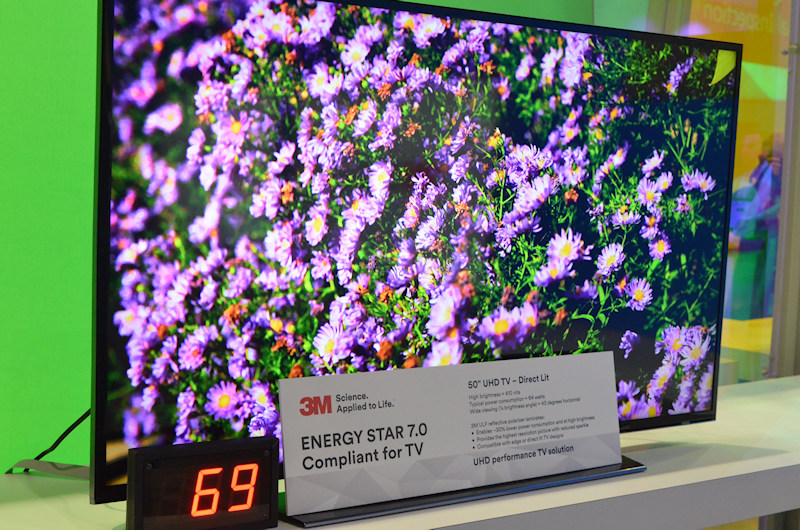Apologies, because of some production issues, these items were omitted from our main SID 2017 report.
Among the many optical films 3M showed in its booth at SID Display Week, was an optimized phone film stack. The conventional stack comprises a silver reflector below the light-guide plate and a diffuser and two prism films above the LGP and below the LCD sandwich. The thickness of this stack (excluding the LGP and the LCD) is 252µm.
3M’s optimized stack consists of a 3M ESR-80v2 reflector under the LGP and a diffuser, 3M ASOC3-106 (24), and 3M APF film between the LGP and the LCD. The thickness of this stack is 254µm, but the center brightness of the testbed phone was 390 cd/m², compared to 230 cd/m² for the conventional stack. The full width of the brightness distribution at half maximum for the optimized stack was 59/63 (V/H), compared to 47/53 for the convention stack. (Units were not given but I assume it’s degrees of angle.)
There’s an even thinner stack consisting of 3M ASR-80, diffusor, 3M ASOC4-LS-82 LH (24), and 3M APF-QWP, which totals 231µm, with an axial center brightness of 420 cd/m² at the cost of a modest reduction of the brightness cone to 52/57 FWHM.
3M also presented its new dual brightness enhancement film (DBEF-PVOH) that acts as both an absorbing and reflecting polarizer. 3M says the product permits the use of fewer films, improves on-axis luminance typically be 15% compared to using DS plus xPrism, and also improves off-axis luminance. The company says the film is compatible with HD, FHD, and UHD resolutions, and with both IPS and VA panels.
3M introduced what it called a new concept in light control film (LCF). The conventional film-based way to control light from automotive dashboard instruments is to apply a film that contains, literally or effectively, louvers that allow the light to reach to drivers eyes but blocks light that would otherwise reflect off the windshild. 3M’s new approach is to replace the louvers with an “engineered refractive structure.” Claimed benefits are improved zone luminance, a 20-30% increases in efficiency, sharp cut-off, and wide viewing angle.
One thing I did not see was 3M’s quantum dot enhancement film (QDEF). Curious. — Ken Werner
 The film stack for this direct-lit 50-inch UHD TV includes 3M’s ULF reflective polarizer laminate. 3M claims 30% less power consumption at the same brightness and reduced sparkle. This set is producing 410 nits at a power consumption of 69 watts. (Photo: Ken Werner)
The film stack for this direct-lit 50-inch UHD TV includes 3M’s ULF reflective polarizer laminate. 3M claims 30% less power consumption at the same brightness and reduced sparkle. This set is producing 410 nits at a power consumption of 69 watts. (Photo: Ken Werner)

